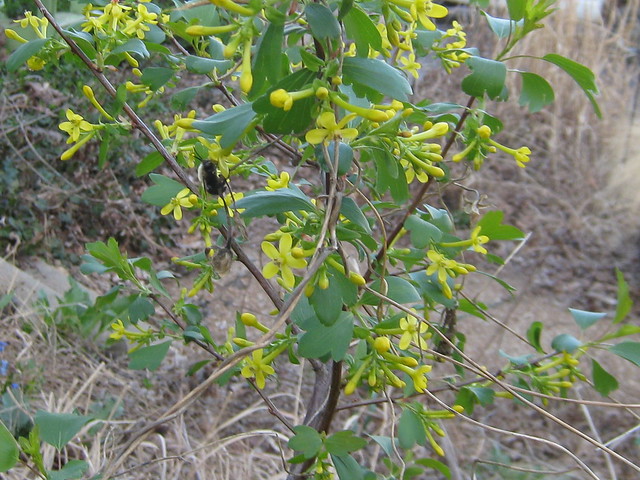Is this plant…
- native to my state?
- enticing to hummingbirds?
- inviting to fruit-eating birds?
- attractive to bees and other pollinators?
- found on Missouri glades?
- fragrant?
- easy to cultivate?
- not so tall that it will obscure the view of the garden?
The blooms have the tubular shape typical of hummingbird-pollinated flowers. Stokes Hummingbird Book (Don & Lillian Stokes, 1989) has a concise summary of the characteristics of the plants in this "exclusive club":
- tube or trumpet-shaped blooms that produce nectar at the base of the tube
- flowers are usually red
- blooms point downward
- flowers have small petals, without a "landing platform" for insects
- flowers produce no fragrance
Let's see… Golden Currant has a tube-shaped bloom, which—in the interest of bringing you the facts—I munched. It was a little sweet, but then, it's a little flower. The flowers are deep yellow, though as the bloom matures, the tips of the corolla show rusty red. On my bushes, the most of the flowers point upward. The petals are tiny. The blooms are wonderfully fragrant. Color me confused. Which pollinator is the plant trying to attract?
Hummingbird Gardens: Attracting Nature's Jewels to Your Backyard (Newfield and Nielsen, 1996) recommends several species of Ribes, including R. odoratum as hummingbird plants, in the chapters on western gardens. I even found this photo of an Anna's Hummingbird visiting currant blooms in California.
I have not seen a hummer at my currant bushes, but I don't usually see them this early in the season. I have seen lots of bees though. I grabbed my close-focus binoculars—the ones I use for butterfly watching—and had a chance to observe the bees closely. Because they have shiny black abdomens, I judged them to be Eastern Carpenter Bees. Some were males with yellow mouth parts that give them a comic, bucktoothed expression. I couldn't really tell what they were doing inside the flower, but carpenter bees are long-tongued, and should be capable of reaching the base of the bloom to lap up the nectar.
Golden Currant's natural range in my state, according to Shrubs and Woody Vines of Missouri (Kurz, 1997), includes only 4 counties: Shannon, Barry, Stone, and Taney. All of these are deep in the Ozarks, and feature dolomite or limestone glades and bluffs. Some sources call it Ribes aureum var. villosum, but list Ribes odoratum as a western species. Searching for R. odoratum often redirects to R. aureum, so I don't know if there is a difference in distribution across the continent, or just name confusion because of a change in botanical classification.
The USDA's site says that the Kiowa used the plant (whether leaves, fruit, or bark is not given) as a remedy for snake bite. The Kiowa believed this remedy was so effective that snakes were afraid of the currant bush. I haven't seen any rattlers near my bushes either! Many tribes used the fruit in the Native American version of the energy bar, pemmican. I'm hoping my bushes produce fruit this year—you'll need 2 to produce fruit—which I'll be glad to see the birds gobble up.

I think so too--I like it almost as much as the bees! Thanks for visiting!
ReplyDeleteAnne... that one has been on my list for a few years... does it really smell as good as they say? Your picture is not quite as "shrubby" looking as I had expected.
ReplyDeleteYes, it really does smell that wonderful! Some nice ladies stopped by to talk to me about their church and we ended up talking about the fragrance. Mine is still a young plant; it may get more dense branching as it matures. I've read though that currant bushes are more casual than formal.
ReplyDeleteI have a red-flowering currant in the middle of my yard. It is blooming right now and I've seen our local Anna's Hummingbird grabbing a snack from it. Great choice of plant!
ReplyDeleteWhat a beautiful native shrub! I'll be looking forward to hearing how the fruit are.
ReplyDeleteI wanted to invite you to the Reading Project meme hosted by The Sage Butterfly. Here's a link for more info: http://thesagebutterfly.blogspot.com/2011/04/earth-day-reading-project-blog-meme.html
Please just let me know yes or no so I can link to your blog on my post. I want to publish my list by Friday.
Hi again Anne, oh I do love the idea of ‘interviewing’ a plant before it arrives in the garden. I should make a list of questions for my Scottish garden too… especially when I too have to squeeze plants in :-D
ReplyDeleteThis plant isn’t familiar to me but it’s fascinating to see it (great pic) and hear all about it. Thanks for sharing it :-D
@Mike: Great to hear that your currant attracts hummingbirds! Maybe mine will too!
ReplyDelete@LisaJennings: I'll give it a try! There are lots of great books to mention.
@shirl: Interviewing a plant expresses the process perfectly, Shirl! I never thought of it.
Hi Anne - a very interesting post, I particularly like the first question on your criteria 'is the plant native to my state'.
ReplyDeleteHere in the UK we have so many problems with invasive plants that I wish others had asked the same questions.
I'm also really envious of you having hummingbirds in the garden.
Hi Richard - We also have problems with invasive plants. One of my gardening goals is to get rid of as many as I can in my own yard. Another goal is to get some decent photos of hummers. I hope folks will visit your blog to see your water voles!
ReplyDelete